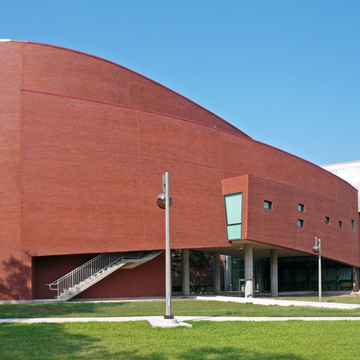You are here
Prairie View A&M University (Alta Vista Agricultural and Mechanical College of Texas for Colored Youth)
Established in 1876 on Alta Vista Plantation after it was deeded to the State of Texas, Prairie View A&M University is the second-oldest institution of higher learning in Texas and the only one located on a former plantation. The campus has six National Register buildings, all of which date to the 1920s or 1930s. Unfortunately, all of the nineteenth-and early-twentieth-century buildings have been demolished including the plantation house, a hospital, a Rosenwald School, and Old Main. The oldest building on campus, the Veterinary Clinic of 1924, is a nondescript brick building with a hipped roof. It is significant as the place where legendary Waller County veterinarian and Prairie View professor emeritus Dr. “Doc” Alfred N. Poindexter practiced and taught from 1945 to 2004.
An agreement in 2000 between the State of Texas and the U.S. Department of Education Office of Civil Rights resulted in the Academic Development Initiative to remove all vestiges of segregation here at Prairie View and at Texas Southern University in Houston and to provide funding for three new buildings on this campus and the School of Nursing building at the University of Texas Health Science Center ( HN54) in Houston. The campus buildings include the Art and Architecture Building (2005, ROTO Architects and HKS) , the Electrical Engineering Building (2005, Kell Muñoz Architects) , and the Juvenile Justice and Psychology and Texas Crime Prevention Center Building (2006, Susman Tisdale Gayle). The Elmer E. O'Banion Science Building (2000) predated the agreement and was designed by 3D/International. Suggestions from the master plan of 2000 by Hellmuth Obata and Kassabaum (HOK) successfully closed the main road through campus to automobiles. Future plans are to remove the road and construct a campus mall.
Mature oak trees line the oldest part of the campus near the six buildings listed on the National Register: W. R. Banks Library, L. C. Anderson Hall, G. R. Woolfolk Social and Political Science Building, Hilliard Hall, Annie Laurie Evans Hall, and the Veterinary Hospital. The last two buildings were designed by Louis E. Fry, who served as chair of the architecture departments at Tuskegee Institute and Lincoln University and whose Washington, D.C., practice designed campus buildings at historically black colleges nationwide. His son, Louis E. Fry Jr., was born in Prairie View and also practiced as an architect.
On FM 1098 between Pond Creek and Cameron Road is the Wyatt Chapel Community Cemetery, an all-black cemetery that was originally part of Alta Vista Plantation grounds. According to oral tradition, slaves of Alta Vista and neighboring Liendo Plantation are buried here. Liendo, the name given to the Groce Plantation by sculptor Elisabet Ney (see AU83), is now a house museum and open for tours.
Writing Credits
If SAH Archipedia has been useful to you, please consider supporting it.
SAH Archipedia tells the story of the United States through its buildings, landscapes, and cities. This freely available resource empowers the public with authoritative knowledge that deepens their understanding and appreciation of the built environment. But the Society of Architectural Historians, which created SAH Archipedia with University of Virginia Press, needs your support to maintain the high-caliber research, writing, photography, cartography, editing, design, and programming that make SAH Archipedia a trusted online resource available to all who value the history of place, heritage tourism, and learning.















